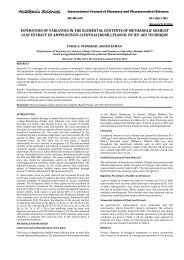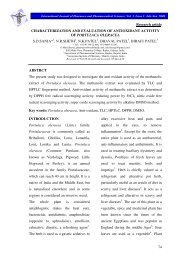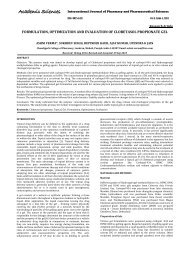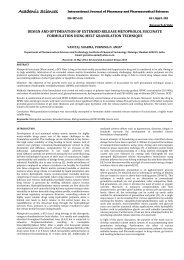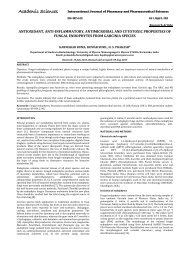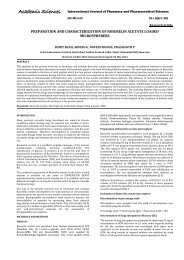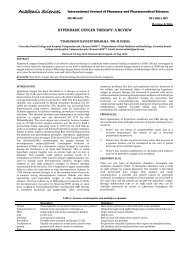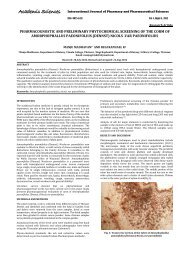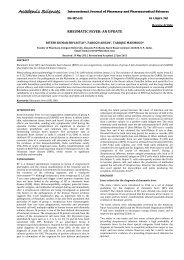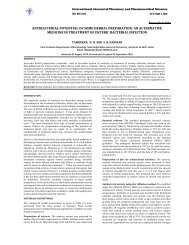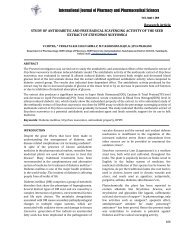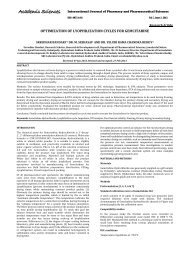frequency and attitudes of using hair dyes among palestinian women
frequency and attitudes of using hair dyes among palestinian women
frequency and attitudes of using hair dyes among palestinian women
You also want an ePaper? Increase the reach of your titles
YUMPU automatically turns print PDFs into web optimized ePapers that Google loves.
Zaid et al.<br />
Int J Pharm Pharm Sci, Vol 5, Suppl 2, 485-488<br />
sale for henna products so that consumers buy the packs from<br />
pharmacies where he will be well informed <strong>and</strong> get the advice he<br />
needs. It is reported in the literature that henna has been known to<br />
cause haemolytic crisis in glucose-6-phosphate dehydrogenase<br />
(G6PD) deficient infants <strong>and</strong> others. In the UAE, Raupp <strong>and</strong> his<br />
colleagues have reported the occurrence <strong>of</strong> haemolytic crisis in four<br />
G6PD-deficient children following topical application <strong>of</strong> henna; <strong>of</strong><br />
these a female neonate recovered after exchange transfusion, <strong>and</strong> a<br />
male infant died despite receiving a transfusion [14]. In particular<br />
people who have (G6PD) deficiency should be informed about the<br />
potentially serious adverse health effects <strong>of</strong> topical application <strong>of</strong><br />
henna. In addition, an awareness program should be established to<br />
inform the public about the risk <strong>of</strong> <strong>using</strong> henna mixed with PPD<br />
(black henna). Palestine is an Islamic country where many people<br />
traditionally use henna for different purposes such as h<strong>and</strong> <strong>and</strong> nail<br />
decoration <strong>and</strong> the dyeing <strong>of</strong> <strong>hair</strong>; it is also used to relieve pain <strong>and</strong><br />
pruritus <strong>and</strong> to treat infections. Hence, people should be aware <strong>of</strong><br />
the potential side effects <strong>of</strong> henna <strong>and</strong> warnings about the risk <strong>of</strong><br />
<strong>using</strong> henna are warranted. When the labels <strong>of</strong> henna products in<br />
our market were reviewed, it was found that some <strong>of</strong> them included<br />
information about ingredients, use, precautions, <strong>and</strong> expiry date<br />
while others did not.<br />
Side effects that could be related to chemical <strong>hair</strong> <strong>dyes</strong> were highly<br />
reported. Itching <strong>and</strong> redness <strong>of</strong> the scalp was reported with <strong>among</strong><br />
20.4% <strong>of</strong> the <strong>women</strong>, this is a very high percentage. For more than<br />
100 years aromatic amine family have been the main agents used in<br />
permanent <strong>hair</strong> <strong>dyes</strong>, <strong>and</strong> more than two thirds <strong>of</strong> <strong>hair</strong> <strong>dyes</strong><br />
currently contain PPD. This compound is an effective <strong>hair</strong> dye owing<br />
to its low molecular weight, its ability to penetrate the <strong>hair</strong> shaft <strong>and</strong><br />
follicle, its strong protein binding capacity, <strong>and</strong> its rapid<br />
polymerization in the presence <strong>of</strong> a coupler (a kind <strong>of</strong> catalyst) <strong>and</strong><br />
an oxidizing agent. However these properties also make PPD an<br />
ideal contact allergen <strong>and</strong>, indeed, it is <strong>among</strong> the most potent<br />
[3,15]. To prevent contact dermatitis to oxidative <strong>hair</strong> coloring<br />
products, a consumer test (skin allergy test, SAT) consisting <strong>of</strong> the<br />
open application <strong>of</strong> the colorant base prior to mixing with the<br />
developer is recommended 48 hours before <strong>hair</strong> coloring. The test is<br />
a suitable tool for the secondary prevention <strong>of</strong> contact allergic<br />
reactions to <strong>hair</strong> coloring products [16], but this practice is not<br />
common in our country. It is good to encourage this practice <strong>among</strong><br />
<strong>women</strong> with a history <strong>of</strong> possible side effects due to <strong>hair</strong> <strong>dyes</strong> to<br />
improve safety <strong>and</strong> try to avoid these effects in the future. Chemicals<br />
in <strong>hair</strong> <strong>dyes</strong> can also cause rhabdomyolysis, laryngeal edema, severe<br />
metabolic acidosis <strong>and</strong> acute renal failure [1].<br />
When <strong>women</strong> were asked if they have ever used <strong>hair</strong> <strong>dyes</strong> during<br />
pregnancy or breast-feeding, only 11 out <strong>of</strong> 149 (7.4%) said yes.<br />
This shows a high awareness <strong>and</strong> concern <strong>of</strong> fetus safety <strong>among</strong><br />
pregnant <strong>women</strong>. Studies regarding teratogenic effects <strong>of</strong> chemical<br />
<strong>hair</strong> <strong>dyes</strong> are not conclusive. Few studies have examined <strong>women</strong>'s<br />
use <strong>of</strong> <strong>hair</strong> dye before <strong>and</strong> during pregnancy. A 2005 study<br />
suggested an association between <strong>hair</strong> dye in pregnancy <strong>and</strong> the<br />
childhood cancer neuroblastoma [17], but other studies haven't<br />
reached the same conclusion [18]. Hair <strong>dyes</strong> are probably safe to use<br />
during pregnancy because so little dye is absorbed through the skin.<br />
However, it is still important to be cautious [4,7], therefore many<br />
health care providers recommend that pregnant <strong>women</strong> not use<br />
permanent <strong>hair</strong> <strong>dyes</strong> during the first three months. While the<br />
absorption through the skin is minimal, the concern is that breathing<br />
fumes during the process could be harmful to the developing baby.<br />
Permanent <strong>hair</strong> <strong>dyes</strong> contain ammonia which has a strong chemical<br />
fume. The recommendation is to avoid <strong>hair</strong> <strong>dyes</strong> that contain<br />
ammonia.<br />
When consumers were asked if they think that <strong>hair</strong> <strong>dyes</strong> may cause<br />
cancer, 21.5% <strong>of</strong> the females answered with yes. In a study from<br />
Saudi Arabia, 36.0% believed that <strong>hair</strong> <strong>dyes</strong> could cause cancer [7].<br />
An association between <strong>hair</strong> <strong>dyes</strong> <strong>and</strong> cancer is an important public<br />
health concerns since a high percentage <strong>of</strong> people use them.<br />
Regarding this risk, the results are inconsistent [4,10]. Non-<br />
Hodgkin’s lymphoma has been associated with use <strong>of</strong> <strong>hair</strong> coloring<br />
products, particularly long-term use <strong>of</strong> dark permanent <strong>dyes</strong> or use<br />
before 1980s, in several epidemiologic studies [19,21]. However,<br />
other investigators have not reported positive associations between<br />
ever use <strong>of</strong> permanent <strong>hair</strong> dye <strong>and</strong> lymphoma [22,23]. Several<br />
studies have suggested an increased risk <strong>of</strong> bladder cancer <strong>among</strong><br />
<strong>hair</strong>dressers, who are occupationally exposed to <strong>hair</strong> <strong>dyes</strong>. There<br />
has also been concern about a possible increased risk <strong>of</strong> bladder<br />
cancer <strong>among</strong> users <strong>of</strong> <strong>hair</strong> <strong>dyes</strong>. However, the association between<br />
personal <strong>hair</strong> dye use <strong>and</strong> bladder cancer risk remains inconclusive<br />
[24]. Women need to underst<strong>and</strong> that <strong>hair</strong> <strong>dyes</strong> might not be<br />
completely safe, so they should not be overused. Many natural<br />
health care experts recommend <strong>using</strong> natural <strong>dyes</strong> <strong>and</strong> doing <strong>hair</strong><br />
dyeing as infrequently as possible. Unfortunately, this study showed<br />
that henna which is the most widely used <strong>hair</strong> dye <strong>among</strong> <strong>women</strong> in<br />
this study was found to cause some side effects <strong>and</strong> is not<br />
completely safe. This finding was associated with presence <strong>of</strong><br />
hazardous chemicals in henna packages. As reported in many<br />
studies, the dangers <strong>of</strong> these chemicals is associated with long term<br />
use <strong>of</strong> henna <strong>and</strong> thus, the carcinogenic hazards <strong>of</strong> these chemicals<br />
may be more frequent. Hair color pr<strong>of</strong>essionals should consider<br />
wearing heavy plastic gloves <strong>and</strong> a mask to protect against fumes<br />
<strong>and</strong> try to schedule color work so that they have a break in between<br />
applications. Consumers, when possible, should look at less toxic<br />
options such as all natural coloring agents.<br />
Regarding the preferred place to get the desired <strong>dyes</strong>, it was<br />
interesting to see that only 30.8% <strong>of</strong> female prefer the community<br />
pharmacies where may receive better information about the<br />
direction <strong>and</strong> safety <strong>of</strong> these products. Therefore, it would be<br />
important to encourage consumers to get their <strong>hair</strong> <strong>dyes</strong> from<br />
pharmacy since pharmacists should aware about potential side<br />
effects <strong>and</strong> the quality <strong>of</strong> these products <strong>and</strong> accordingly they can<br />
advise the consumers especially in case <strong>of</strong> pregnancy or lactation.<br />
CONCLUSIONS<br />
It is concluded that a high percentage <strong>of</strong> <strong>women</strong> use <strong>hair</strong> <strong>dyes</strong> in our<br />
country <strong>and</strong> henna is widely used. The public should be informed<br />
about the risks associated with excessive <strong>hair</strong> dye use. Women<br />
should underst<strong>and</strong> that natural <strong>dyes</strong> are not completely free from<br />
side effects. It is important that there is labeling <strong>of</strong> the ingredients <strong>of</strong><br />
<strong>hair</strong> dye packs with date <strong>of</strong> manufacture <strong>and</strong> expiry. In addition,<br />
instructions on use should be included so that sensitive individuals<br />
are aware <strong>of</strong> any possible allergenic ingredients prior to purchase<br />
<strong>and</strong> use. Ministry <strong>of</strong> Health should oblige importers to report<br />
important relevant information on ingredients, use, precautions,<br />
possible side effects <strong>and</strong> expiry date on products. It should also<br />
conduct analysis on coloring products for hazardous chemicals such<br />
as PPD <strong>and</strong> restrict sale to pharmacies where proper advice can be<br />
provided to consumers.<br />
REFERENCES<br />
1. Sampathkumar K, Yesudas S. Hair dye poisoning <strong>and</strong> the<br />
developing world. J Emerg Trauma Shock 2009; 2(2): 129-131.<br />
2. Boldoc C, Sapiro, J. Hair care products: Waving, straightening,<br />
conditioning <strong>and</strong> coloring. Clin Dermatol 2001; 19 (4): 431-<br />
436.<br />
3. McFadden JP, White IR, Frosch PJ, Sosted H, Johansen JD,<br />
Menne T. Allergy to <strong>hair</strong> dye. BMJ 2007; 334(7587): 220.<br />
4. Chua-Gocheco A, Bozzo P, Einarson A. Safety <strong>of</strong> <strong>hair</strong> products<br />
during pregnancy- personal use <strong>and</strong> occupational exposure.<br />
Can Fam Physician 2008; 54 (10): 1386-1388.<br />
5. Al-Suwaidi A, Ahmed H. Determination <strong>of</strong> paraphenylenediamine<br />
(PPD) in henna in the United Arab Emirates.<br />
Int J Environ Res Public Health 2010; 7(4): 1681-1693.<br />
6. Polat M, Dikilitaş M, Oztaş P, Alli N. (2009) Allergic contact<br />
dermatitis to pure henna. Dermatology Online Journal 2009;<br />
15(1):15.<br />
7. AlGhamdi KM, Moussa NA. Knowledge <strong>and</strong> practices <strong>of</strong>, <strong>and</strong><br />
<strong>attitudes</strong> towards, the use <strong>of</strong> <strong>hair</strong> <strong>dyes</strong> <strong>among</strong> females visiting a<br />
teaching hospital in Riyadh, Saudi Arabia. Ann Saudi Med 2011;<br />
31(6):613-9.<br />
8. Søsted H, Hesse U, Menné T, Andersen KE, Johansen JD. Contact<br />
dermatitis to <strong>hair</strong> <strong>dyes</strong> in a Danish adult population: an<br />
interview-based study. Br J Dermatol 2005; 53(1):132-5.<br />
9. Takkouche B, Etminan M, Montes-Martínez A. Personal use <strong>of</strong><br />
<strong>hair</strong> <strong>dyes</strong> <strong>and</strong> risk <strong>of</strong> cancer: a meta-analysis. JAMA 2005;<br />
293(20):2516–2525.<br />
487



